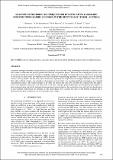Files in this item
Analysis Of filtering techniques for investigating landslide-induced topographic changes in the Oetz Valley (Tyrol, Austria)
Item metadata
| dc.contributor.author | Gutierrez, I. | |
| dc.contributor.author | Før Gjermundsen, E. | |
| dc.contributor.author | Harcourt, W. D. | |
| dc.contributor.author | Kuschnerus, M. | |
| dc.contributor.author | Tonion, F. | |
| dc.contributor.author | Zieher, T. | |
| dc.date.accessioned | 2020-09-18T15:30:05Z | |
| dc.date.available | 2020-09-18T15:30:05Z | |
| dc.date.issued | 2020-08-03 | |
| dc.identifier | 269884766 | |
| dc.identifier | a185e09e-0525-41e8-a819-b8c2e05c883a | |
| dc.identifier | 85091122832 | |
| dc.identifier.citation | Gutierrez , I , Før Gjermundsen , E , Harcourt , W D , Kuschnerus , M , Tonion , F & Zieher , T 2020 , ' Analysis Of filtering techniques for investigating landslide-induced topographic changes in the Oetz Valley (Tyrol, Austria) ' , ISPRS Annals of Photogrammetry, Remote Sensing and Spatial Information Sciences , vol. V-2-2020 , pp. 719-726 . https://doi.org/10.5194/isprs-annals-V-2-2020-719-2020 | en |
| dc.identifier.issn | 2194-9042 | |
| dc.identifier.other | crossref: 10.5194/isprs-annals-V-2-2020-719-2020 | |
| dc.identifier.other | ORCID: /0000-0003-3897-3193/work/79918396 | |
| dc.identifier.uri | https://hdl.handle.net/10023/20649 | |
| dc.description.abstract | Landslides endanger settlements and infrastructure in mountain areas across the world. Monitoring of landslides is therefore essential in order to understand and possibly predict their behavior and potential danger. Terrestrial laser scanning has proven to be a successful tool in the assessment of changes on landslide surfaces due to its high resolution and accuracy. However, it is necessary to classify the 3D point clouds into vegetation and bare-earth points using filtering algorithms so that changes caused by landslide activity can be quantified. For this study, three classification algorithms are compared on an exemplary landslide study site in the Oetz valley in Tyrol, Austria. An optimal set of parameters is derived for each algorithm and their performances are evaluated using different metrics. The volume changes on the study site between the years 2017 and 2019 are compared after the application of each algorithm. The results show that (i) the tested filter techniques perform differently, (ii) their performance depends on their parameterization and (iii) the best-performing parameterization found over the vegetated test area will yield misclassifications on non-vegetated rough terrain. In particular, if only small changes have occurred the choice of the filtering technique and its parameterization play an important role in estimating volume changes. | |
| dc.format.extent | 11811516 | |
| dc.language.iso | eng | |
| dc.relation.ispartof | ISPRS Annals of Photogrammetry, Remote Sensing and Spatial Information Sciences | en |
| dc.subject | LiDAR | en |
| dc.subject | Change detection | en |
| dc.subject | Landslide | en |
| dc.subject | Terrain extraction | en |
| dc.subject | ISPRS Innsbruck Summer School of Alpine Research | en |
| dc.subject | QC Physics | en |
| dc.subject | QE Geology | en |
| dc.subject | T Technology | en |
| dc.subject | NDAS | en |
| dc.subject | SDG 15 - Life on Land | en |
| dc.subject.lcc | QC | en |
| dc.subject.lcc | QE | en |
| dc.subject.lcc | T | en |
| dc.title | Analysis Of filtering techniques for investigating landslide-induced topographic changes in the Oetz Valley (Tyrol, Austria) | en |
| dc.type | Journal article | en |
| dc.contributor.institution | University of St Andrews. School of Physics and Astronomy | en |
| dc.identifier.doi | 10.5194/isprs-annals-V-2-2020-719-2020 | |
| dc.description.status | Peer reviewed | en |
This item appears in the following Collection(s)
Items in the St Andrews Research Repository are protected by copyright, with all rights reserved, unless otherwise indicated.

